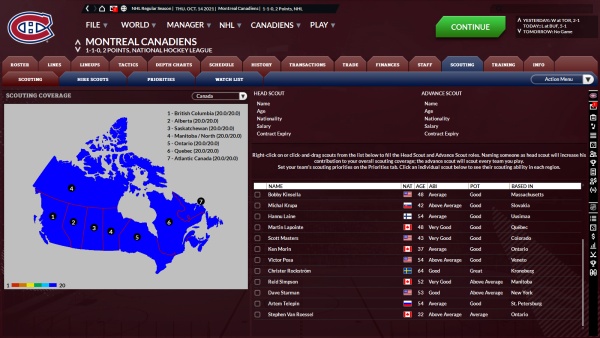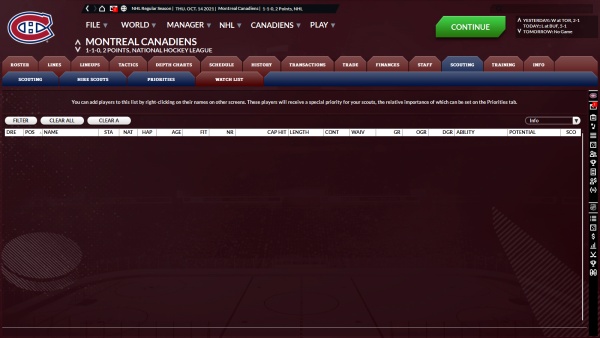| Find in this manual | ||
| Replace with | ||
Scouting in FHM allows you to evaluate players who you may want to acquire, or those who are already part of your team. In modern hockey, virtually every player with any serious potential has seen some scouting by the time he reaches the age in which players appear in our game. So, FHM scouting is based on the general principle of your scouts determining whether or not the "conventional wisdom" about a player is correct or not - and if it isn't, to what degree and in what direction is the error?

Head Scout
Assign a Head Scout by dragging his name to the Head Scout slot. You should choose one of your best scouts, as his ratings will add a bonus to your overall scouting coverage. If your scouting staff is limited in size, you should also consider choosing a Head Scout in one of your higher-priority regions
Advance Scout
Assign an Advance Scout by dragging his name to the Advance Scout slot. You should choose a scout with a high Scouting Ability (ABI) one of your best scouts, as his ratings will add a bonus to your overall scouting coverage.
Scouting Coverage
Every scout you hire adds an individual amount to your total Scouting Coverage in a particular region; the exact amount depends on his skills and the area he is based in. Click on the checkbox beside a scout's name to see the exact amount he contributes. The higher the Scouting Coverage number, the more accurate your scouting in that region will be. It uses a 1-20 scale, like the individual scouting ratings, so think of this as the equivalent of a collective scouting rating for your entire team.
Note that it is impossible to raise the Scouting Coverage number above 20, so there's little point in adding more scouts in a region where your coverage is already maximized.

Hiring Scouts
The Hiring Scouts tab shows you which scouts are available for you to hire for your team. As on the main scouting screen, you can click on their checkbox to see what they will add to your Scouting Coverage in each region. To hire a scout, right-click on their name or open their staff profile and use the Action Menu.

Priorities
The Priorities tab shows you which player types, map areas, and regions will be given scouting priority. The priorities work left to right and top to bottom, so, for example, if you have Prospects, Canada, and Ontario in the top slots, the first players your scouts look at will be prospects playing in Ontario. Once they've completed scouted those players, they'll move on to the next priority, going right to left. So, in the previous example each Canadian region would be checked, then the scouts would go on to the next entry on the Maps list.
Scouts will only look at players who have the potential to be good enough to play in your league, so a reasonably-sized scouting staff will move through an entire region reasonably quickly (the more scouts, the faster, but the speed does not increase any further after you've hired the 20th scout.)
Player Types:
- Watch List: players that have been added to the Watch List (see below)
- Prospects: players whose age is 0-2 years under the league's minimum age.
- International Tournaments: players on the roster of any team in an international tournament that is currently being played
- Free Agents: unsigned players not on any team)
- Own League: players on the active roster of teams in your league
- Other Leagues: any player on the active roster of a team not in your league

Watch List
The Watch List allows you to identify specific players to be scouted. Just right-click any player to add or remove them from the list. They will get a special priority for scouting, depending on what slot "Watch List" is in in your Player Type settings on the Priorities tab (since they're presumably the players you're most interested in, it's advisable to leave Watch List in the top position there.)
Note that if you have turned the Manager Options setting to have the AI handle your scouting, you can still add players to the watch list, but they will be automatically removed when they have been fully scouted and reach the "A" Scouting Level.

Scouting Grade:
Scouting Grades are indicated for each player by two letters, one upper-case (the Scouting Level) and one lower-case (the Success Chance).
The Scouting Level is indicated for each player as a lower-case letter beside the ability/potential star rating. Scouting levels affect the accuracy and amount of information displayed for a player. Basically, every player has a general consensus about his skill level and potential in the scouting community. This may or may not be accurate. It's up to your scouts to weed out any errors in that evaluation, and the scouting level indicates how much effort they have put into doing that:
- E: unscouted, only talent/future talent displayed for player with no reduction in the inherent error
- D: scouted, attributes displayed, error reduced slightly by an amount dependent on the scout's skill
- C: scouted twice, error reduced moderately
- B: scouted three times, error reduced significantly
- A: scouted four times, error reduced heavily, maximum level
The level has to be be maintained: players will eventually regress to the next lowest level, the chance of a regression getting increasingly larger the longer they go unscouted.
The Success Chance indicates how likely the player is, in the opinion of your scouts, to reach his listed potential. a = Almost certain to reach potential, e = very unlikely to reach potential.
Reports:
Your scouting staff will also periodically report to you, presenting lists of various players that might be of interest to you.

Player Reports
The player screen includes a Scouting tab, which gives you a detailed report on all the information you have on the player and your scouts' opinions of him.

League Scouting
In modern games, your league may provide additional scouting feedback on players eligible for the next draft via a group of scouts employed directly by the league. They will send reports four times per season:
The Futures List, issued first, shows the top prospects in alphabetical order; no attempt is made to rank them.
The Pre-Season Watch List comes next, shows more players, and divides them into three letter groups: "A" (possible first rounders), "B" (possible second and third rounders) and "C" (the remainder).
The Midterm Ranking in January is the first actual ranking of individual players.
The Final Ranking in May updates the rankings prior to the draft.